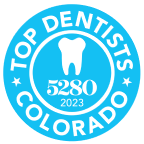 Gum recession exposes the teeth roots and significantly increases the risk for tooth decay, gum disease, and other oral health issues. A gum graft at Metropolitan Dental Care is the most effective treatment for a receding gum line. This procedure involves adding gum tissue to the area of deficiency. The tissue can either be autogenous (from the patient’s palate) or non-autogenous (donor tissue). Here, your Denver Dentist explores this procedure a bit more and discusses five major benefits of this treatment.
Gum recession exposes the teeth roots and significantly increases the risk for tooth decay, gum disease, and other oral health issues. A gum graft at Metropolitan Dental Care is the most effective treatment for a receding gum line. This procedure involves adding gum tissue to the area of deficiency. The tissue can either be autogenous (from the patient’s palate) or non-autogenous (donor tissue). Here, your Denver Dentist explores this procedure a bit more and discusses five major benefits of this treatment.
If you have dental sensitivity, exposed teeth roots, or other symptoms of gingival recession, schedule an appointment at Metropolitan Dental Care. Call us today at 303-534-2626.
What causes gingival recession?
Before we delve into the benefits of a gum graft, let’s explore what causes gum recession to begin with. There is a common misconception that it is always due to aggressive brushing. While this is certainly one reason for gum recession, there are several other factors that contribute to the problem. For example, heredity plays a major role. If an immediate family member has gum recession, you are far more likely to develop the condition yourself.
Five Benefits of a Gum Graft
Gum grafting offers a wide range of oral health benefits. Here are four of them:
- Gum grafting reinforces the gum tissue around a tooth, strengthening and stabilizing it.
- The procedure protects the area from future recession.
- A gum graft covers the exposed teeth roots, thereby decreasing the risk of dental sensitivity.
- If recession occurs around the visible front teeth (or, the smile zone), a gum graft can restore the appearance of your smile.
- The success rate for gum grafting is impressively high. In fact, with proper care, a graft can offer lifelong advantages.
Your Initial Consultation
To determine if you’re a good candidate for a gum graft, your Denver dentist performs a comprehensive oral assessment. After visually assessing the areas of recession, x-rays may also be taken of the affected teeth. This allows us to evaluate the health of the supporting bone and assess the extent of damage.
If your Denver dentist believes you qualify for gum grafting, we will schedule you for an appointment with our in-house periodontist, Dr. Mike Norouzinia.
Gum Graft Procedure
The type of gum graft recommended for you will depend on the area of recession and the severity of the condition. For example, recession in the smile zone will be treated with an aesthetic graft called a connective tissue graft. This type of graft consists of tissue taken from underneath the top layer of the palate. During this procedure, the graft is placed underneath the existing gum tissue and sutured into place.
If recession is particularly severe, or if it occurs between the lower front teeth, a free gingival graft is often recommended. This type of graft is taken directly from the surface of the palate and is placed in a pocket created by your surgeon. Once healing has occurred, the outline of the graft may still be slightly visible – but the gum tissue will be strong and resilient against further damage.
Call Your Denver Dentist Today
Want to learn more about gum grafts at Metropolitan Dental Care? Schedule an appointment with your Denver dentist by calling 303-534-2626. You can also contact us online anytime. Our team is ready to answer any questions you may have.

